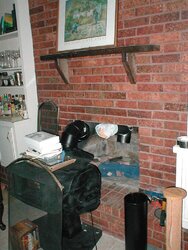So, after getting our liner installed, I realized I screwed up with the measurements of the stove. I didn't take into account that a 90 degree elbow coming out of the top of a stove ends up adding so much height. Basically, the problem is that I would have to use two 90 degree elbows and then about 12 inches of straight stove pipe to get my stove connected to the tee in the fireplace, all running at a slight downward slope with the two elbows making a "hump" coming out of the top-venting stove. On the hearth.com installation page it says that stovepipe must run upward with at least 1/4" lift per foot of pipe. Will this work or do I need to rethink the whole thing? I think if I seal the sections of pipe with furnace cement, the creosote should flow into the tee cleanout. I just don't know what this mess will do to my draft.
Stove pipe problem
- Thread starter runderwo
- Start date
-
Active since 1995, Hearth.com is THE place on the internet for free information and advice about wood stoves, pellet stoves and other energy saving equipment.
We strive to provide opinions, articles, discussions and history related to Hearth Products and in a more general sense, energy issues.
We promote the EFFICIENT, RESPONSIBLE, CLEAN and SAFE use of all fuels, whether renewable or fossil.




